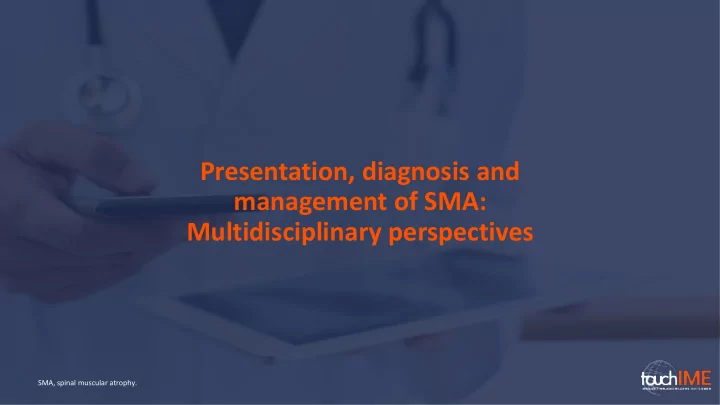

Presentation, diagnosis and management of SMA: Multidisciplinary perspectives SMA, spinal muscular atrophy.
What are the emerging treatments for SMA patients and how can these address unmet needs in clinical practice? Dr Eduardo Tizzano Director of the Department of Clinical and Molecular Genetics, Hospital Vall d’Hebron , Barcelona, Spain SMA, spinal muscular atrophy.
Disclaimer Unapproved products or unapproved uses of approved products may be discussed by the faculty; these situations may reflect the approval status in one or more jurisdictions. The presenting faculty have been advised by touchIME to ensure that they disclose any such references made to unlabelled or unapproved use. No endorsement by touchIME of any unapproved products or unapproved uses is either made or implied by mention of these products or uses in touchIME activities. touchIME accepts no responsibility for errors or omissions.
Mode of action of available SMN-enhancing therapies AVXS-101* Healthy individual 1 SMA patient 2 (onasemnogene abeparvovec) • Delivers a functional copy of SMN1, SMN1 gene SMN1 gene increasing full-length SMN production 100% full-length SMN protein 0% full-length SMN protein Nusinersen* • Antisense oligonucleotide promotes SMN2 gene SMN2 gene transcription of full-length SMN2 ~10% full-length SMN protein ~10% full-length SMN protein ~90% SMN protein lacking exon 7 ~90% SMN protein lacking exon 7 (non-functional) (non-functional) SMN2 copy number = full-length SMN SMN2 copy number = full-length SMN ➢ Clinical severity of SMA is related to number of SMN2 copies, with a lower copy number being linked to more severe types of SMA. 1,2 *Regulatory approval of AVXS-101 and nusinersen may vary with geographic location. SMA, spinal muscular atrophy; SMN, survival motor neuron. 1. Bowerman M, et al. Dis Model Mech. 2017;10:943 – 954. 2. Calucho M, et al. Neuromuscul Disord. 2018;28(3):208 – 215.
Efficacy and safety of nusinersen CHERISH 2 : 126 patients with SMA2 (symptom onset >6 mo) ENDEAR 1 : 121 patients with SMA1 • Interim analysis (<7 mo old with symptom onset at <6 mo) Mean increase in HFMSE score: • Final analysis (n=110) • +4 points vs -1.9 points (control) • Achievement of HINE-2 milestones: • Least mean squares difference 22% full head control 5.9 points; p<0.001 Control group: • Similar AE incidence between groups 10% able to roll over 0% 8% independent sitting all milestones NURTURE 3 : 25 patients with SMA and two or three SMN2 1% able to stand copies (presymptomatic) • At interim analysis with 2.9 years of follow-up: • Similar AE incidence between groups, and • All patients were alive and none required tracheostomy fewer SAEs with nusinersen or permanent ventilation • 100% could sit without support • 92% could walk with assistance • 88% could walk independently AE, adverse event; HFMSE, Hammersmith Functional Motor Scale – Expanded; HINE-2, Hammersmith Infant Neurologic Examination Part 2; mo, months; SMA, spinal muscular atrophy; SMN, survival motor neuron; SAE, serious adverse event. 1. Finkel RS, et al. New Engl J Med. 2017;377:1723 – 32. 2. Mercuri E, et al. New Engl J Med. 2018;378:625 – 635. 3. De Vivo D, et al. Neuromuscul Disord 2019;29:842 – 856.
Efficacy and safety of AVXS-101 START study 1 When all patients had reached ≥20 mo: • Two Grade 4 elevated 0 +7.7 +24.6 15 patients aminotransferases SMA1, age <8 mo patients required mean increase in mean increase in considered Symptoms at ≤3 mo permanent CHOP-INTEND with low CHOP-INTEND with high treatment related ventilation dose (n=3) dose (n=12) STR1VE study 2 Mean +11.8 points Mean +7 points CHOP-INTEND 22 patients with SMA1 after 3 months after 1 month score: <6 mo at treatment CHOP-INTEND, Children’s Hospital of Philadelphia Infant Test of Neuromuscular Disorders scale; mo, months; SMA, spinal muscular atrophy. 1. Mendell JR, et al. New Engl J Med. 2017;377:1713 – 1722. 2. Novartis. https://www.novartis.com/news/media-releases/avexis-data-reinforce-effectiveness-zolgensma- treating-spinal-muscular-atrophy-sma-type-1 (accessed December 2019).
Small molecule SMN-enhancing drugs in development SMN2 splicing modifiers: risdiplam and branaplam SMN2: SMN2: 8 8 8 non-functiona l 8 functiona l 7 7 7 6 6 6 6 ~90% of SMN protein from SMN2 is transcribed Splicing modifiers promote the transcription of full- without exon 7 and is non-functional 1 length, functional SMN protein including exon 7 2,3 • These agents are orally administered and distribute to peripheral tissues as well as the central nervous system 2,3 SMN; survival motor neuron. 1. Bowerman M, et al. Dis Model Mech. 2017;10:943 – 954. 2. Poirier A, et al. Pharmacol Res Perspect. 2018;6(6):e00447. 3. Calder AN, et al. J Med Chem. 2016;59(22):10067 – 10083.
Non-SMN-directed options in development Neuroprotective agents 1 Neuromuscular junction stabilizers • Salbutamol is a β 2-adrenoreceptor agonist which may act at the neuromuscular junction 2 These approaches • Pyridostigmin is an acetylcholinesterase could potentially be inhibitor that improves combined with neuromuscular transmission 3 SMN-enhancing therapies 4 Skeletal muscle activation • Reldesemtiv is a fast skeletal troponin activator which increases muscle contractility 4,5 • SRK-015 enhances muscle mass via myostatin inhibition 6 SMN, survival motor neuron. 1. Shorrock HK, et al. Drugs. 2018;78:293 – 305. 2. Pera MC, et al. Neuromuscul Disord . 2018;28(10):863 – 864. 3. Stam M, et al. BMJ Open. 2018;8(7):e019932. 4. Bowerman M, et al. Dis Model Mech. 2017;10:943 – 954. 5. SMA News Today. https://smanewstoday.com/ck-2127107-ck-107-cytokinetics-astellas (accessed December 2019). 6. Cote SM, et al. SLAS Discov. 2019 Jul 26. doi: 10.1177/2472555219860779 (Epub ahead of print).
MDT considerations for SMN-enhancing therapies 1-3 Cost:benefit ratio Relative inexperience Need for earlier and evolving phenotypes (pre-symptomatic) diagnosis with new treatments MDT, multidisciplinary team; SMN, survival motor neuron. 1. NeurologyToday. https://journals.lww.com/neurotodayonline/Fulltext/2019/04180/Two_New_Treatments_for_Spinal_Muscular_Atrophy_May.8.aspx (accessed December 2019). 2. Farrar MA, et al. Ann Neurol. 2017;81:355 – 368. 3. Tizzano EF, Finkel RS. Neuromuscul Disord. 2017;27:883 – 889.
Recommend
More recommend